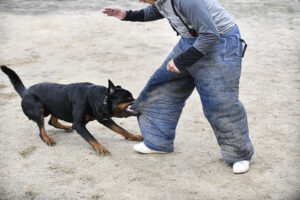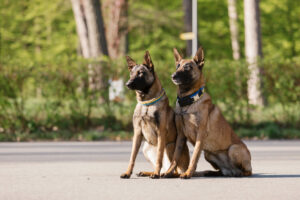






Well, meet Blitz—my dog, technically—a huge, purebred German shepherd protection dog.
But still, when he sits, he melds into my leg, rubs his cheek against my knee, and nestles his rear toward my foot. His tail sweeps back and forth in a joyful rhythm. Those soulful eyes gaze up at me, brimming with devotion and affection. A true softie at heart.
And a stranger enters our space. Blitz’s body shifts instantly—his ears perk up, muscles stiffen, and a low growl rumbles in his chest. His body, once relaxed and playful, transforms into a wall of muscle. His focus? Sharp as a blade, locked onto the stranger like a laser.
This instinct, this ability to switch gears, from loyal friend to fierce guardian, is what defines a protection dog.
But it’s easy to confuse protection dogs with guard dogs, and while both serve important roles in security, they are not the same.
Protection dogs like Blitz are trained to defend their humans in times of danger, building a deep, unbreakable bond. Guard dogs, on the other hand, are typically focused on protecting property. They’re more independent, often territorial, and have a different approach to security.
Choosing between a protection dog and a guard dog is no small decision. And knowing the right fit could be one of the most important decisions you make for your security.
So, let’s walk you through the key differences to help guide you toward the most suitable option for your situation.
| Aspect | Protection Dogs | Guard Dogs |
| Primary Purpose | Personal protection and safety | Territory protection and property security |
| Training Focus | Respond to direct threats to their human | Patrol and deter intruders from specific areas |
| Human Interaction | High—close bond with owner/family | Low—more independent, less personal bonding |
| Territorial Instinct | Moderate | High |
| Temperament | Calm, confident, but highly alert | Aloof, territorial, and often more aggressive |
| Typical Environment | Homes, families, high-risk individuals | Businesses, large estates, law enforcement |
Protection dogs are expertly trained defenders ready to protect you and your family in potentially dangerous situations.

What makes protection dogs stand out is their intuitive bond with their handlers. They don’t just react to commands; they read you. If you’re anxious or tense, they pick up on it. If you’re relaxed, so are they.
This ability to sync with their owner’s emotions makes them a unique asset in personal security.
Unlike what some might assume, protection dogs aren’t aggressive 24/7. They’re calm and composed until action is necessary.
Their training ensures they remain poised, providing security without adding unnecessary risk. These dogs can be integrated into everyday family life. They’re great with children, social with friends, and they can even get along with other pets.
But when danger arises? They act swiftly and decisively, using their advanced training to neutralize threats effectively.
For individuals or families seeking a companion who doubles as a bodyguard, a protection dog is an unbeatable choice.
Let’s shift gears and talk about guard dogs—they’re a different breed altogether, both figuratively and often literally.
While protection dogs like Blitz are my constant companions, guard dogs serve a distinct purpose that’s equally important in the right context.
Their focus isn’t on forming a bond with humans but on protecting a designated area. Whether it’s a business, estate, or warehouse, guard dogs are territorial by nature and thrive on their autonomy.
Their primary method of defense? Intimidation. A loud, booming bark is often enough to scare off potential intruders.
Guard dogs are far more independent than protection dogs, and their loyalty lies with their territory, not their owner. They’re trained to be suspicious of anyone entering their space, regardless of intent.
Depending on their level of training, guard dogs may serve various roles:
Trained to bark loudly when someone approaches, serving as a deterrent without physical intervention.
Often used to guard expansive outdoor areas like warehouses or shipyards, sentry dogs roam freely without instruction from their handler. They are trained to attack anyone trespassing, making them a top choice for property protection in these environments.
These dogs are trained to attack and, in extreme cases, kill upon command from their handler. Used primarily in law enforcement and the military, they are not suitable as pets.
The training that protection dogs undergo is intense and tailored to their role in personal defense.
They are taught to assess situations and respond only when there is a genuine threat. Their actions are calculated and focused on minimizing risk, not causing harm.
Guard dogs, in contrast, are trained to be territorial and reactive. They don’t form the same personal connection with their owners as protection dogs do. Plus, their training emphasizes deterring intruders, often through intimidation or physical restraint.
While both types of dogs receive specialized training, protection dogs prioritize control and precision, while guard dogs focus on defending their space, often with a more aggressive stance.

Some places have pretty strict rules when it comes to using dogs for security purposes, and you don’t want to find yourself on the wrong side of them.
For instance, in some areas, protection dogs are required to be trained to a certain standard, and there could be restrictions on what’s considered “reasonable” use of force.
Guard dogs, on the other hand, may need to be registered or confined to specific areas, and you might even need to post warning signs on your property.
It’s always a good idea to consult local regulations or seek legal advice before making your decision.
It largely depends on your specific security needs and lifestyle.
Consider a protection dog if:
A guard dog might be more suitable if:
It’s worth noting that the lines between these categories can blur.
Some dogs can be trained to perform both roles to some extent. However, it’s generally more effective to choose a dog specifically trained for your primary need.
If you’re serious about upgrading your security, do yourself a favor—reach out to Vanguard Protection Dogs. We’re not just dog trainers; we’re dedicated to helping people like you find the perfect security companion.
Our approach?
We take the time to get to know you, to understand your lifestyle, your needs, and your unique security concerns. Only then do we hand-select a dog that will smoothly integrate into your life, providing the ultimate protection you need.
Contact us today and let us work our magic!